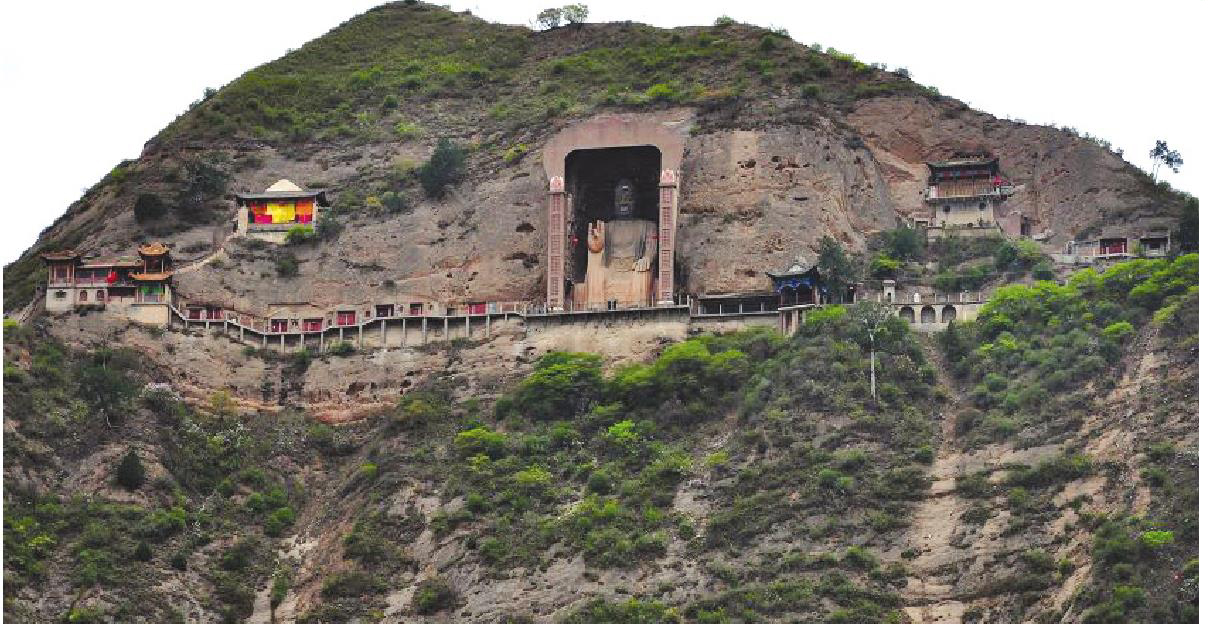大像山石窟
石窟寺。在今甘肃甘谷县城西南约3公里处。今存洞窟22个,主窟为大佛窟。其西侧有7窟,东侧有14窟。东西窟塑像均毁。大佛窟高约30余米,内有石胎泥塑释迦牟尼像一尊,高23.2米,腰阔10.4米,丰颐短颈,高肉髻,蝌蚪状短须,披袈裟,结跏趺坐于莲台。穹顶及两侧残存悬塑菩萨、达摩、飞天、卷云、莲叶等。此大佛在北宋编成的《太平寰宇记》里已有记载。今人认为,可能开创于北魏,唐代完善,后代又有加工修饰。大象山还有墨子殿、伏羲殿、接引佛殿、文昌阁、鲁班殿、财神殿、韦陀殿、无量殿、三圣殿等殿阁。1981年公布为省级文物保护单位。
大像山石窟
位于甘谷县城西南2.5公里的文旗山上,石窟开凿年代待考。据有关资料记载,东汉初期,文旗山因岗峦起伏,苍翠叠嶂,而成为风景名胜之地。北朝以后,佛教盛行,开始在此大规模修造石窟,经历代不断修缮营建,遂成为一组依山脊一线分布、规模宏大的建筑群。各建筑错落多姿,结构严谨,布局精妙,与巍峨峭拔的山势交相辉映,融为一体,妙趣天成。无量殿以下主要以木结构建筑为主,其中以鲁班殿最具特色,结构奇巧,八面玲珑,别具一格。无量殿以上以石窟群为主,以大象山石窟为中心,东侧以“松花崖”为界,西侧以“飞云岩”为界,形制多为方形平顶的殿堂间禅窟式,尤以大象山石窟为其精华。大佛殿位于窟群中部的山崖之巅,为一座长方形的圆拱形大殿。大佛高23.3米,肩宽9.5米,在全国石胎泥塑的大佛中居第七,是大型石窟造像中为数不多的珍贵文物。该石窟为省级文物保护单位。
大像山石窟
唐末石窟寺。全国重点文物保护单位。位于甘谷县城西南 2.5 公里的文旗山,因大型摩崖佛像而得名,开凿年代不祥。自山脚拾阶而上至最高处三圣殿千余米山脊,依山就势,建有一组规模宏大的建筑群。主体建筑大佛殿位于中部的山崖之巅,为一座长方形的圆拱形大殿,系唐代所建。大佛高 23.3 米,肩宽 9.5 米,头高 5.8 米,膝长 6 米。在全国石胎泥塑的大佛中居第 7 位,是大型石窟中为数不多的珍贵文物。人佛整个身躯为半圆雕,比例匀称,神态自然;头部为大螺旋形高肉髻;两眉间有毫光,细眉大眼,眼角较长;鼻高而直,腮部丰满;嘴大唇厚,上唇有蝌蚪状短须;双耳垂肩,颈圈三道;内着僧祗支,腰系一带于胸前打结,外着圆领下垂的袈裟;左手扶膝、右手举起,作施普济众生状;结跏趺坐于云形台座上,袒胸赤足,脚踩莲台,显得肃穆慈祥,含蓄深沉。大佛殿四周有小龛 70 余个,每龛前原有泥质塑像,为供养菩萨、伎乐飞天、罗汉、天王、力士、夜叉、人画鸟、卷云。窟檐原系木结构三层阁楼式,因长期风雨侵蚀,致使殿宇坍塌,大佛手足遭损,经 1982—1985年抢修补塑,基本恢复原貌。

大像山石窟
大像山石窟
位于甘谷县城西南2.5公里处的文旗山。北宋《太平环宇记》中曾有记载,今人认为可能创建于北魏,唐代完善,后代又有加工修饰。现存洞窟22个,主窟为大佛窟。其西侧有7窟,东侧有14窟,窟内塑像均已不存。大佛窟为一平面作长方形的圆拱形大窟,高34米, 宽14米,深4.5米,内有石胎泥塑释迦牟尼佛像一尊,高23. 2米,肩宽9. 5米,腰阔10.4米。据其风格推断为盛唐作品。虽经后代维修,仍保持原作风格。造像为半圆雕,比例匀称,神态自若。头部为大螺旋形高肉髻,细眉大眼,眉间有毫光,鼻直口阔,上唇有蝌蚪状短须,丰颐短颈, 双耳垂肩, 内着僧祗支, 外着袈裟, 善跏趺坐,赤足踩在莲台上,神态肃穆慈祥,含蓄深沉。穹顶及两侧残存悬塑菩萨、达摩、飞天、卷云、莲叶等。沿山脊一线依次分布有古建筑15处,多系明、清所建,有墨子殿、伏羲殿、接引佛殿、文昌阁、鲁班殿、财神殿、韦陀殿、无量殿、三圣殿等。每组建筑自成一体,又互相呼应,错落多姿,布局精妙。大像山石窟中的大佛,是陇东石窟中形体最为巨大的佛像,并弥补了这一地区唐代造像不足的缺憾。为省级文物保护单位。
大像山石窟
甘肃省境内的佛教石窟。位于甘肃省甘谷县城南1000米处。大像山原有大小石窟20个,塑像295身,殿宇11座,多数已毁。现仅存大像,高约38米,石胎泥塑。佛龛高42米,有3层楼阁式密檐。佛袒胸赤足,面相丰润,前颈胸上有3道线纹,上着通肩大衣,下着长裤短裙。四周悬塑飞天,凌空展翅。据窟内所存清同治年间碑文记载,石窟凿于宋嘉祐三年(1058年),近人认为该佛造像形态、装饰及洞窟形制与敦煌莫高窟、炳灵寺石窟的盛唐之作极为相似,其时代也应大体相当。